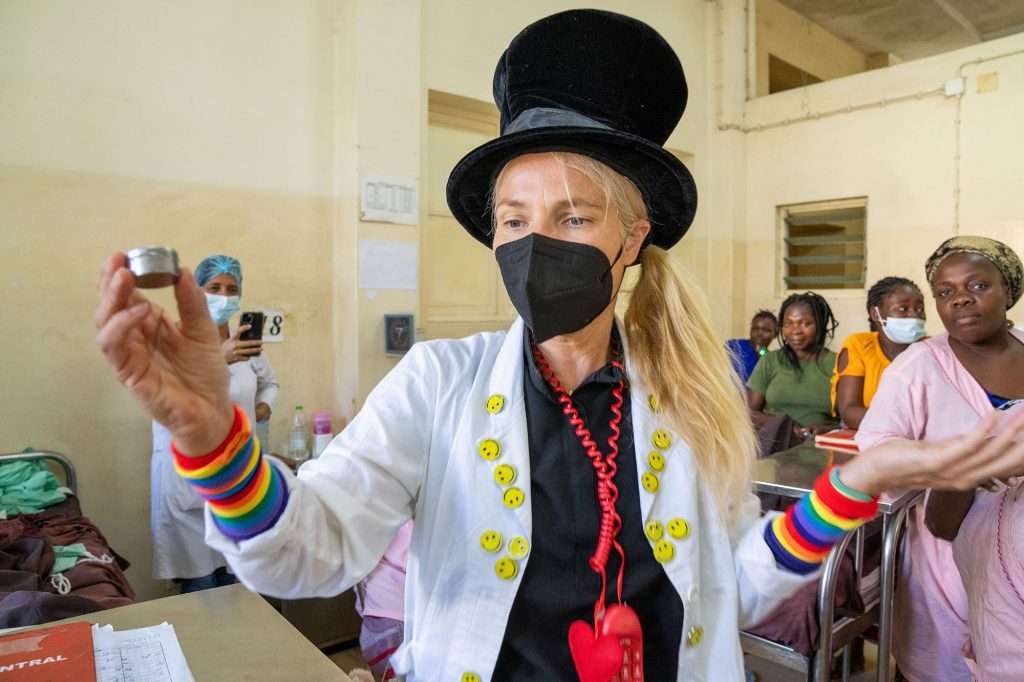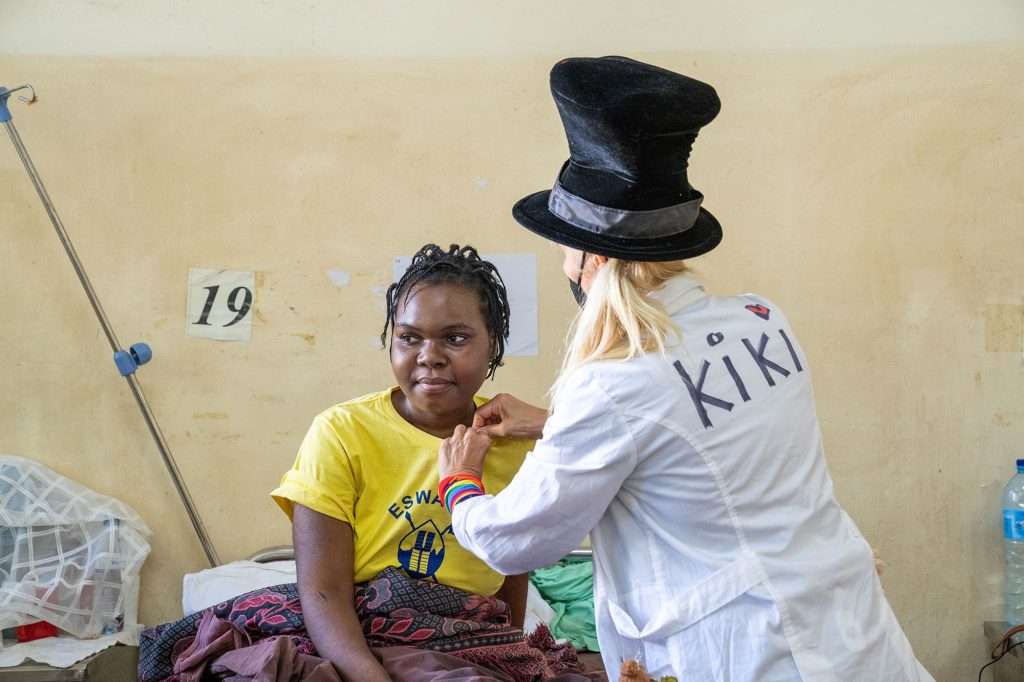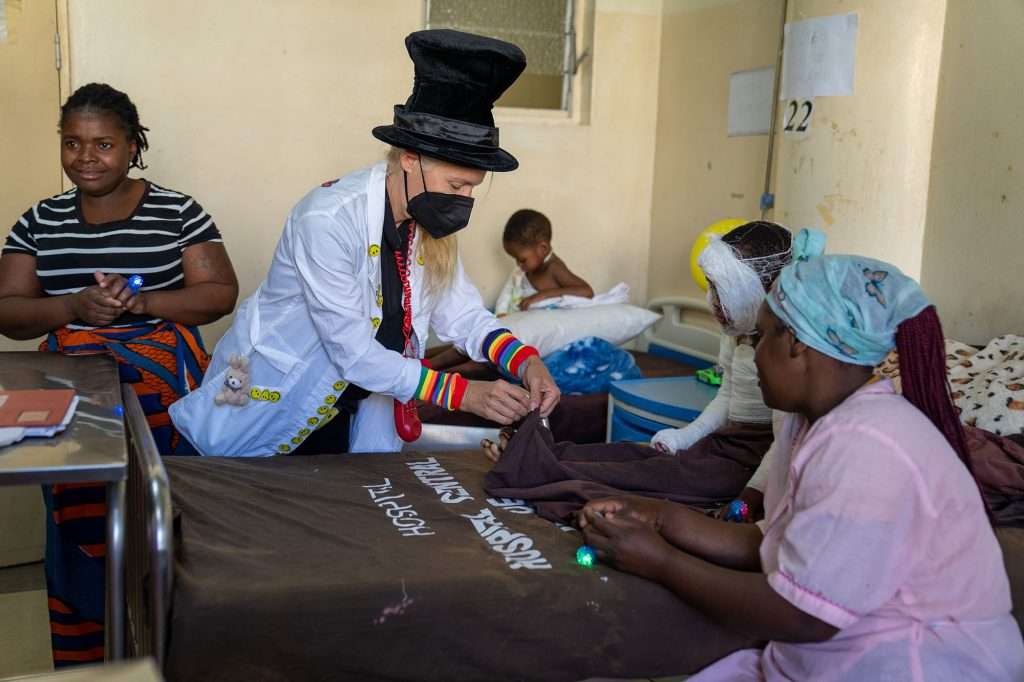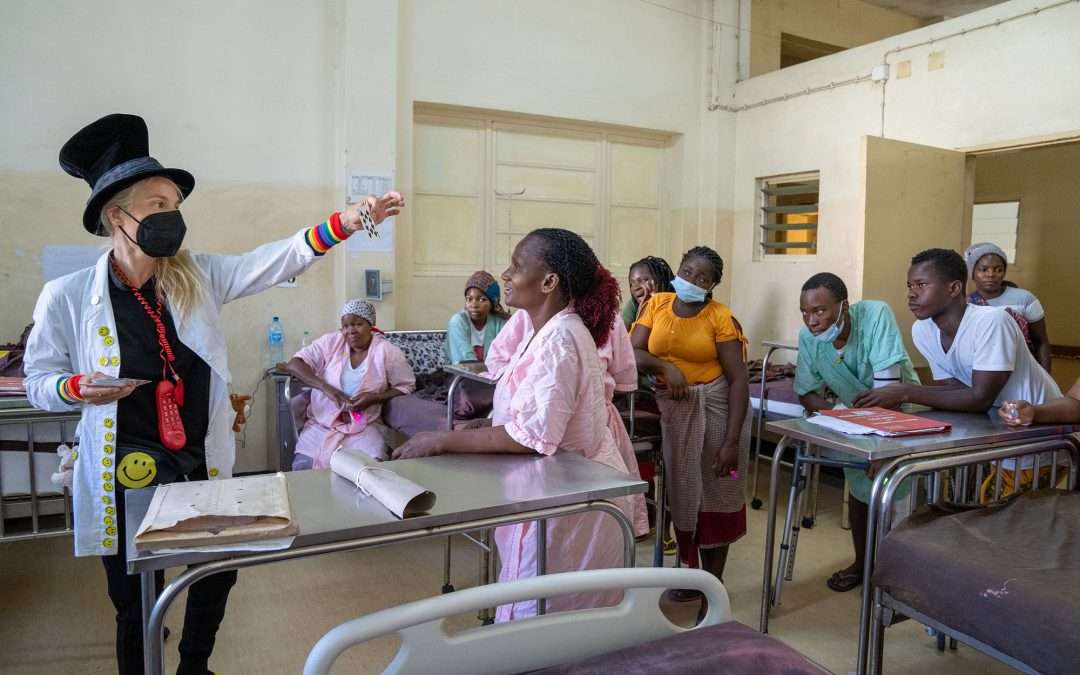By Carole Kulber AKA Kiki the Clown
Nothing could have prepared our medical team for the mission at Maputo Central Hospital in August 2024.
Life can be so dark in a medical mission and the stories are not happy stories. My name is Kiki (the Clown) and I follow the nursing team.
The patients at the burn ward of Maputo hospital are suffering from horrible burns. Some of them cry and get better; some of them cry and die.
There are the mothers of the burned kids sleeping on the floor next to the hospital bed, in a large communal room. They don’t know if their child will survive.
I am a Clown Magician. I sing, dance, and make things appear and disappear. Most importantly, I spread joyful magical sparkles on kids and adults to take them away to a happy place. What I do can be described as a shimmer of light in the middle of the storm, a glistening, colorful rainbow during rainy days.
Below is one of many, very sad stories… with a happy ending.
I believe in magic. Do you?
DAY 1
Observations
8 am: Arrival at Mozambique’s central burn ward.
Brought medical supplies and organized them in Dr. Celma Issufo’s office. This is not our first mission at Maputo Central Hospital. After a brief meeting with Dr. Issufo, the surgical team left us to start surgery.
In the ward: Nurses (Debbie, Sandra, and Katie), a Volunteer (Noah), a Medical
Student (Louie), and myself, Kiki the Clown.
Observations: None of the nurses that we met last year are here anymore. No leadership. The beds are dirty. The wounds are infected. Sadness.
9 am: Our team tries to help the local nurses clean the wounds properly and change the burn dressings.
The screaming starts. I have never heard such deep screaming. Kids from one room to another room with agonizing screams.
I am in Dr. Issufo office organizing the medical supplies we brought with Kyla, the 11-year-old daughter of the Mozambican surgeon Dr. Pedro Santos.
Our team of nurses and volunteers are coming back to Dr. Issufo’s office I ask them, “What happened? What is all the screaming about?” It is very bad.
They reply that they don’t understand. The local nurses told them that they gave morphine to the kids but the kids looked like they were in excruciating pain during the dressing changes.

Day 2
A Life-Saving Wake-Up Call
8 am: Arrival at Mozambique’s central burn ward.
Today, our team is going to figure out their protocol for pain management. Is there a protocol for pain medication? What are they giving to the kids before changing their dressings?
Upon arrival, the screams are already in full swing. This is not possible. The local nursing team began the dressing changes at 10 am yesterday… this is too early!
When our team enters the mold-filled patient halls, they realize the local nurses are already finishing the dressings, and the kids look like they are again in excruciating pain.
Suddenly, our team saw that one of the kids in a bed was convulsing repeatedly. It was a grand mal seizure. Debbie marked the time as the length of the seizure is clinically paramount for management. The kid stopped breathing and foam came out of his mouth.
Louie runs to a poorly stocked “crash cart” in the hallway. By some miracle, there is an AmbuBag (used to ventilate or artificially breathe for a patient. However, it’s an adult Ambubag that barely fits over the kid’s mouth. As the nurses start ventilation, Louie listens to the kid’s chest for breathing sounds (evidence that the AmbuBag breathing is working).
Nothing.
The mask is too big and no seal can be made. The kid’s head is titled back and the mask from the AmbuBag is smothered across his face. Finally, they help him breathe.
5 local nurses attempt to place a line—9 attempts jabbing the kid and on the tenth they succeed. He is taken to the pediatric intensive care unit. The seizure lasted 6 and a half minutes. The kid’s blood was so acidic from lack of oxygen (a pH of 7.07, practically incompatible with life). The kid lives to see another day. But, the reaction of the local resident physician: we see 10-minute seizures all the time. The local nurses didn’t know what to do and he surely would have died.
In the morning, the local nurses started the dressing changes really early so they didn’t have to explain to anyone what they were doing—right or wrong. It is sad. But now hopefully, after saving a kid’s life today, our team will be appreciated and respected.

Day 3
Pain Management Protocol
8 am: Arrival at Mozambique’s central burn ward.
Beginning of the dressing changing and “pain management protocol.”
Our team can finally observe the local team actualize a pain management protocol and the full change of dressing operation.
The screams again! What can be so wrong? What can be done?
You give pain medication to the kid and then half an hour later you start the changing of the dressing. But the local nurses are giving the pain medication only AFTER the dressing changes?!?!
So, during the dressing changes, the kids are screaming/kicking, in excruciating pain. No pain relief.
Day 4
Demonstration Day
7 am: Arrival at Mozambique’s central burn ward.
Demonstration — Our team is showing the local team:
- How to administer intranasal opioid analgesics and how much;
- Change the dressing, the kid doesn’t scream or kick. He is not in pain.
- Our team demonstrated that this is good for the kid. No more hellish pain and
good for the local nurses as it is easier to change the dressing without the screaming.

Day 5
Stopping the Screaming
7 am: Arrival at Mozambique’s central burn ward.
Louie writes a protocol to follow for pain medication and changing of dressings for the local nurses. Hoping that they will keep following it when our team leaves and they can stop the screaming!
The amazing news: our nursing team and Louie are now in contact with the head nurse and she has been reporting that they used a new pain management medication that they can get locally and that was recommended by our team. They continued to ask questions about the protocol and expressed great interest in it.
We stopped the screaming!!
Thank you to our nurses Debbie, Sandra, and Katie, and to our volunteers Noah, Louie,and Kyla.
Doctors in developing countries get the help of doctors from developed countries through the mentor/mentee program — now time for the nurses. ❤


Recent Comments